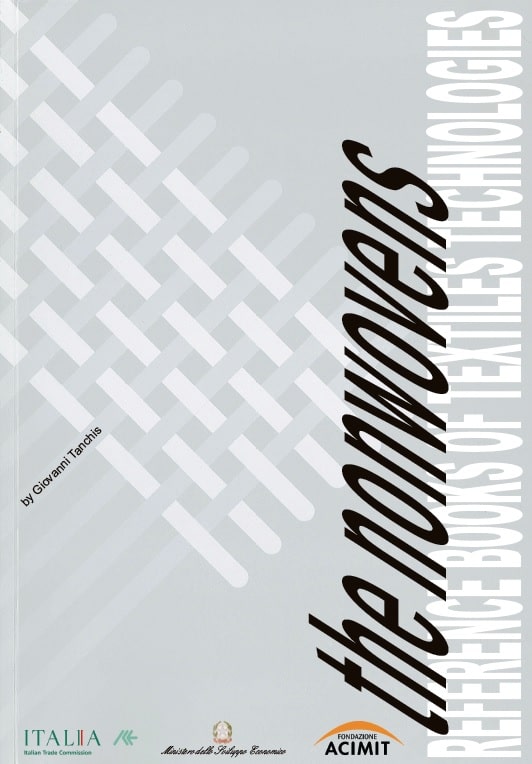
INDEX
Chapter 1 Generalities ……………………………………………………………………………11
1.1 Definition of the term ìnonwovenî…………………………………………………………………… 11
1.2 Historical outline ……………………………………………………………………………………………. 12
1.3 Application sectors …………………………………………………………………………………………. 14
Chapter 2 ñ Production processes………………………………………………………………17
2.1 The raw materials …………………………………………………………………………………………… 17
2.1.1 Properties of the fibres…………………………………………………………………………………….. 22
2.1.2 The evolution of the fibres……………………………………………………………………………….. 24
2.2 The manufacture of nonwovens ……………………………………………………………………….. 27
2.3 The production of drylaid webs………………………………………………………………………… 29
2.3.1 Fibre opening…………………………………………………………………………………………………. 29
2.3.2 Fibre oiling ……………………………………………………………………………………………………. 38
2.3.3 Carding …………………………………………………………………………………………………………. 39
2.3.4 Garnett machine……………………………………………………………………………………………… 44
2.3.5 Carding machine…………………………………………………………………………………………….. 45
2.4 Folding systems ……………………………………………………………………………………………… 49
2.5 Drawing machines …………………………………………………………………………………………. 50
2.6 Web formation by vertical folding ……………………………………………………………………. 50
2.7 The airlaying process………………………………………………………………………………………. 51
2.7.1 Characteristics of raw material and fibre preparation ………………………………………….. 52
2.7.2 Technology of airlaying processes ……………………………………………………………………. 55
2.7.3 Evolution of airlaying processes ………………………………………………………………………. 63
2.7.4 Air flow and fibre dynamics in airlaying processes …………………………………………….. 64
2.7.5 Web bonding …………………………………………………………………………………………………. 65
2.7.6 Physical properties and practical applications of airlaid nonwovens……………………… 66
2.8 Production of wetlaid webs ……………………………………………………………………………… 67
2.8.1 Raw materials ………………………………………………………………………………………………… 69
2.8.2 Preparation of raw materials…………………………………………………………………………….. 73
2.8.3 Technology of web forming process …………………………………………………………………. 74
2.8.4 Bonding systems…………………………………………………………………………………………….. 77
2.8.5 Finishing treatments ……………………………………………………………………………………….. 79
2.9 Web formation by direct spinning…………………………………………………………………….. 79
2.9.1 Raw materials ………………………………………………………………………………………………… 80
2.9.2 Nonwoven production by direct spinning ………………………………………………………….. 83
2.9.3 Extrusion spinning………………………………………………………………………………………….. 84
2.9.4 Spunbond production systems………………………………………………………………………….. 87
2.9.5 Process variables …………………………………………………………………………………………… 93
2.9.6 Structure and properties of spunbond nonwovens……………………………………………….. 97
2.10 Production of meltblown nonwovens………………………………………………………………… 99
2.10.1 Process technology ……………………………………………………………………………………….. 100
2.10.2 Studies on process parameters………………………………………………………………………… 100
2.10.3 Characteristics and properties of meltblown nonwovens……………………………………. 102
2.11 Composite fabrics and other extrusion processes………………………………………………. 103
2.11.1 CoformÆ……………………………………………………………………………………………………… 103
2.11.2 Flashspinning……………………………………………………………………………………………….. 103
2.11.3 Electro-spinning …………………………………………………………………………………………… 104
2.11.4 Centrifugal spinning system …………………………………………………………………………… 107
2.11.5 Future trends………………………………………………………………………………………………… 107
Chapter 3 ñ Bonding methods ………………………………………………………………….108
3.1 Mechanical bonding ……………………………………………………………………………………… 108
3.1.1 Stitchbonding or needlebonding …………………………………………………………………….. 108
3.1.2 Recent developments in stitchbonding…………………………………………………………….. 116
3.2 Needlepunching …………………………………………………………………………………………. 117
3.2.1 Technology of the needlepunching process………………………………………………………. 122
3.3 Bonding by hydroentangling ………………………………………………………………………….. 127
3.3.1 Technology of the hydroentangling process ……………………………………………………. 135
3.3.2 Multilayer (composite) hydroentangled nonwovens ………………………………………….. 143
3.4 Thermobonding ……………………………………………………………………………………………. 144
3.4.1 Materials ……………………………………………………………………………………………………… 145
3.4.2 Calender (contact) bonding …………………………………………………………………………… 147
3.4.3 “Through-air” and impingement bonding ………………………………………………………. 152
3.4.4 Ultrasound bonding ………………………………………………………………………………………. 154
3.5 Chemical bonding…………………………………………………………………………………………. 155
3.5.1 Chemical binders ………………………………………………………………………………………….. 156
3.5.2 Mechanism of chemical bonding…………………………………………………………………….. 161
3.5.3 Binder application methods……………………………………………………………………………. 163
3.5.4 Drying…………………………………………………………………………………………………………. 168
Chapter 4 ñ Finishing of nonwovens…………………………………………………………172
4.1 Wet finishing treatments………………………………………………………………………………… 172
4.2 Chemical finishes …………………………………………………………………………………………. 174
4.2.1 Methods for chemical finishes application……………………………………………………….. 175
4.3 Mechanical finishing treatments……………………………………………………………………… 178
4.4 Emerging technologies ………………………………………………………………………………….. 182
4.5 Cutting and winding ……………………………………………………………………………………… 183
Chapter 5 ñ Characterization of nonwovens……………………………………………..194
5.1 Norms for nonwoven analysis ………………………………………………………………………… 194
5.1.1 Norms for medical nonwovens……………………………………………………………………….. 194
5.1.2 Norms for air filtration ………………………………………………………………………………….. 194
5.2 Characterization of nonwoven structure ñ Generalities ……………………………………… 194
5.3 Characterization of bonding structure ……………………………………………………………… 196
5.3.1 Needlepunched nonwovens ……………………………………………………………………………. 196
5.3.2 Wetlaid nonwovens ………………………………………………………………………………………. 197
5.3.3 Stitchbonded nonwovens……………………………………………………………………………….. 197
5.3.4 Thermobonded nonwovens ……………………………………………………………………………. 198
5.3.5 Chemically bonded nonwovens………………………………………………………………………. 198
5.4 Measurement of basic parameters …………………………………………………………………… 198
Chapter 6 ñ Nonwoven applications …………………………………………………………205
6.1 The products ………………………………………………………………………………………………… 205
6.2 The ìintelligentî nonwovens ñ The new applications………………………………………… 207
6.2.1 Biodegradable nonwovens……………………………………………………………………………… 207
6.2.2 Medical nonwovens………………………………………………………………………………………. 212
6.2.3 Nonwovens against electromagnetic pollution………………………………………………….. 219
6.2.4 Protection against radiations…………………………………………………………………………… 221
6.2.5 Nonwovens with thermoregulating properties ………………………………………………….. 222
6.2.6 Tridimensional textiles ………………………………………………………………………………….. 222
Multilingual dictionary ……………………………………………………………………………224
Foreword
I am pleased to present the sixth volume of a series of ìNotebooksî on textile machines technologies, which Foundation ACIMIT worked out for the use of textile institutes and of universities with textile engineering degree courses.
The subject of this Notebook are the machines for the production of nonwovens, a market segment of utmost importance and at the same time in rapid expansion within the Italian textile machinery industry.
The need to prepare real textbooks for textile schools dates back already to the year 1999, after a specific invitation by Italian universities and by textile technical institutes. Thanks to the work started at that time, which saw the enthusiastic contribution of a group of teachers of these textile technical institutes, Fondazione ACIMIT succeeded in putting at the disposal of the Italian students 5 Notebooks on the most up-to-date technologies in the sectors of spinning, weaving, knitting, man-made fibres and finishing. With present Handboook on nonwovens, the publications of Fondazione ACIMIT are enriched with a treatise of certain interest for a sector, which in these years has been characterized by a rapid technological development.
The success of these publications (their total circulation exceeds today 18.000 copies), as well as the relations maintained with the major textile schools and universities abroad, also convinced our Fondazione of the opportunity to translate the Notebooks into English, Chinese and Arab languages, so as to enable their distribution through CD-ROMs also in countries which enjoy a well-established textile tradition.
We would appreciate any suggestion and amendment coming from operators involved in this subject (teachers, students, factory technicians, etc.), in order to enhance the scope and use of these publications.
